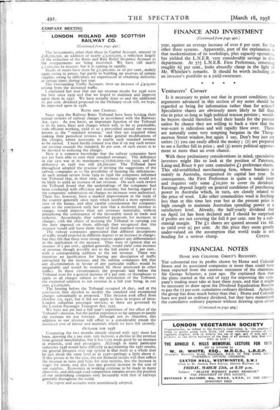L.N.E.R. RENEWALS POLICY
In his address to London and North Eastern stockholders Mr. William Whitelaw has at last cleared up one of the hitherto unsolved mysteries of the home railway market. For years one has wanted to know exactly where the London and North Eastern stood in the matter of renewals, and recently I suggested, in the absence of any explanationin the accounts, that the relatively sharp increase in net receipts in 1937 was due at least in part to a reduction in the rolling stock renewals provision. That was a fair deduction from the available data, but happily for stockholders the position is rather more favourable than appeared. Mr. Whitelaw now assures us that for 1936 and 1937 the L.N.E.R. adopted a formula for its renewals charge on revenue on all fours with that adopted by the other three trunk systems.' The company, it seems, fell sadly into arrears with its renewals during„the depression, but thanks to the windfall of rates relief was able to credit a sum of £3,340,000 from this source to rolling stock renewals fund.
The position today is quite healthy. Arrears of renewals accumulated during the depression had been practically wiped out, as a result of an extensive programme of rebuilding, by the end of last year, and there is still a credit of over £2,000,000 in the rolling stock renewals fund. It is surprising, all the same, that the increase in maintenance in renewal expenditure on the L.N.E.R,. was less than 2 per cent. last
(Continued on page 492.)
-FINANCE AND INVESTMENT
(Continued from page 490.) year, against an average increase of over 6 per cent. for the other three systems. Apparently, part of the explanation is that modernisation of its workshops, plus capacity operation, has yielded the L.N.E.R. very considerable savings in this department. _ At 571 L.N.E.R. First Preference, returning roughly 61 per cent., looks absurdly cheap in the light of Mr. Whitelaw's remarks. It should be worth including in an investor's portfolio as a yield-sweetener.















































 Previous page
Previous page